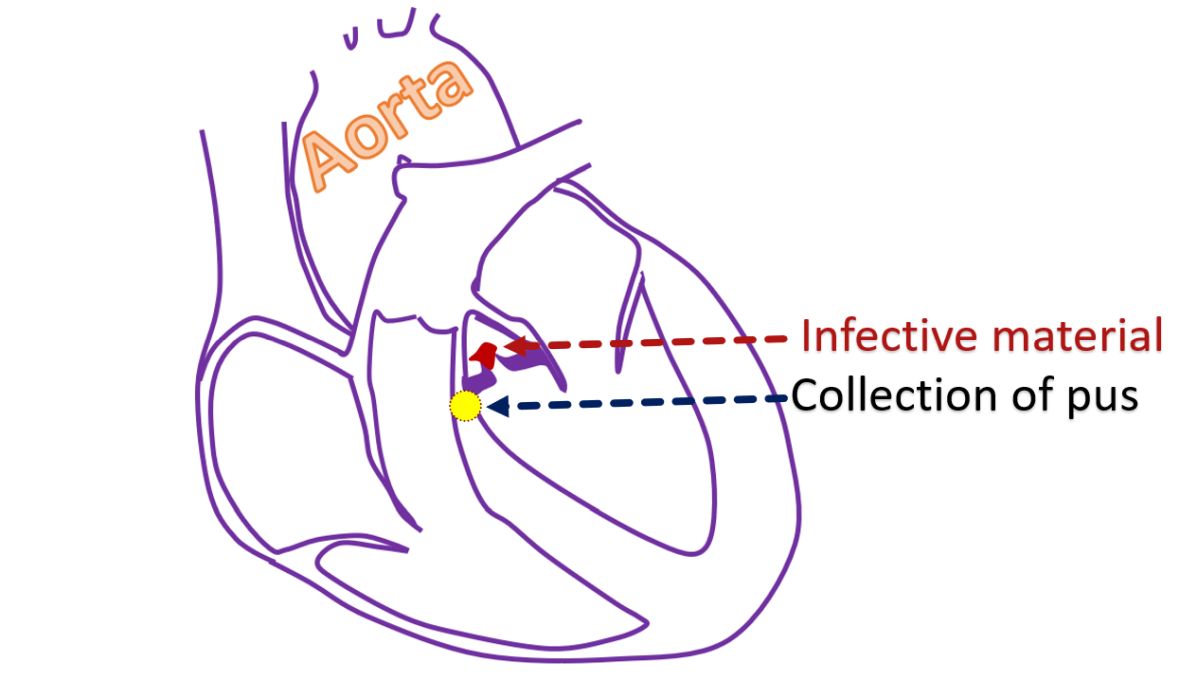What is infective endocarditis?
What is infective endocarditis?
Endocardium is the inner lining of the heart, including heart valves. Infective endocarditis means infections of the endocardium, mainly the heart valves, though it can occur at places where there is an abnormal communication between the heart chambers. Example is a ventricular septal defect between the two lower chambers of the heart. Infections could be due to bacteria, virus or fungus. Some terminologies call it as infectious endocarditis as well. Endocarditis can also occur due to non-infectious causes like certain disorders of the immune system and cancer.

Infective endocarditis usually affects valves already damaged by some other disease like rheumatic heart disease. A normal valve can be affected if the immune system is weak or if the person is having injectable drug abuse. In that case it is usually the right sided heart valves which are affected first. Otherwise infective endocarditis is more common in left sided heart valves. The right sided heart valves are the tricuspid valve and pulmonary valve. Left sided heart valves are the mitral valve and aortic valve.

Infective endocarditis has been divided into acute and subacute by the time course of development. Acute endocarditis develops and progresses rapidly while subacute endocarditis develops and progresses slowly. Though both are serious disorders, acute endocarditis is immediately more dangerous. Generally, subacute infective endocarditis is more common than acute infective endocarditis. Acute endocarditis has a higher risk of spreading to the regions of the heart near the valves, producing collection of pus around the valve (valve ring abscess). When an aortic valve endocarditis spreads, it can damage the conduction system of the heart which is very near it. This can produce complete heart block, an electrical block, different from the blood vessel block which produces a heart attack.

While acute infective endocarditis can have high fever, subacute infective endocarditis has subtle presentation. Low grade fever may be there for a long period before the heart valve infection is detected. Infections on artificial heart valves are more dangerous than that on native valves. Hence those with artificial heart valve or those with a previous episode of infective endocarditis must take preventive antibiotics for medical procedures including tooth extraction. This applies to those with complicated birth defects of the heart as well.
Sometimes subacute infective endocarditis can manifest with a complication. The infective material on the valves known as vegetations, can break off and get lodged elsewhere in the blood circulation. It can start an infective process with localized enlargement of the blood vessel known as mycotic aneurysm. A mycotic aneurysm in the brain can rupture and bleed, producing a stroke. Large vegetations can also break away and block blood vessels elsewhere, producing damage to the organ with blocked blood vessel. Kidneys are often affected in infective endocarditis and causes problem in giving medications which are excreted through the kidneys.
An echocardiogram (ultrasound study of the heart) is often used to pick up infective endocarditis. Small infective structures attached to the heart valves or near regions of abnormal communication between heart chambers are the hallmark of infective endocarditis. They are called vegetations and comprise of the microorganisms and clot like material. Echocardiogram will also show the damage to the heart valves like a perforation of the leaflets with leak. If there is a collection of pus near the heart valve, that can also be documented by an echocardiogram. Collection of pus may need an urgent surgery to remove it, along with the infected valve.
The organism which has caused the infection is determined by a blood test known as blood culture. Though medications for the suspected microorganism is started soon after taking the blood for culture, it is modified if needed when the culture report is obtained after a few days. Repeat blood cultures are taken later to confirm eradication of the organism from the blood. Infective endocarditis needs prolonged treatment for complete removal of the microorganism from the blood and body cells. Duration will vary depending on the type of microorganism.
Some cases of infective endocarditis with severe damage to the heart valves or pus collection around it may need surgery. The infected valve and surrounding infected material are removed during surgery. This helps the medications to work better on the remaining microorganisms. An artificial valve is implanted in place of the removed valve to maintain the valve function. Sometimes an infection can occur in relation to a cardiac implantable electronic device (CIED) like a pacemaker. In such cases, the device may have to be removed temporarily and re-implanted later after sterilization, or even a new device given.


